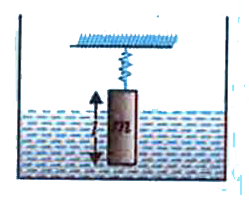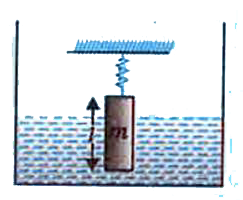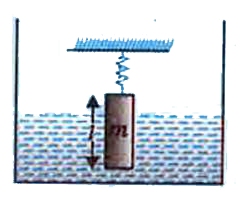A uniform cylinder of height h, mass m and cross sectional area A is suspended vertically from a fixed point by a massless spring of force constant k, A beaker full of water is placed under the cylinder so that 1/4th of its volume is submerged in the water at equilibrium position. When the cylinder is given a small downward push and released, it starts oscillating vertically with small amplitude. Calculate the frequency of oscillation of the cylinder, Take, density of water =ρ.
To calculate the frequency of oscillation of the uniform cylinder suspended from a spring, we will follow these steps:
Step 1: Understand the forces acting on the cylinder
When the cylinder is at equilibrium, the forces acting on it are:
- The spring force (upward) given by Fs=kx, where x is the displacement from the equilibrium position.
- The buoyant force (upward) due to the displaced water, which can be calculated as Fb=Vρg, where V is the volume of the submerged part of the cylinder, ρ is the density of water, and g is the acceleration due to gravity.
Step 2: Determine the volume of the submerged part of the cylinder
The volume V of the submerged part of the cylinder can be expressed as:
V=A⋅h4
where A is the cross-sectional area and h is the height of the cylinder.
Step 3: Write the equation of motion
When the cylinder is displaced by a small distance x downwards, the net force acting on it can be expressed as:
Fnet=Fs+Fb−mg
Substituting the expressions for the forces, we have:
Fnet=kx+A⋅h4ρg−mg
At equilibrium, the spring force balances the weight and buoyant force:
mg=k⋅0+A⋅h4ρg(at equilibrium)
Step 4: Set up the equation for small oscillations
For small displacements, we can use Hooke's law. The net force can be written as:
Fnet=−kx−A⋅h4ρg
This leads to the equation of motion:
md2xdt2=−(k+A⋅h4ρg)x
Step 5: Identify the angular frequency
From the equation of motion, we can identify the angular frequency ω:
ω2=k+A⋅h4ρgm
Step 6: Calculate the frequency of oscillation
The frequency f is related to the angular frequency by:
f=ω2π=12π√k+A⋅h4ρgm
Final Answer
Thus, the frequency of oscillation of the cylinder is:
f=12π√k+A⋅h4ρgm
When the cylinder is at equilibrium, the forces acting on it are:
- The spring force (upward) given by Fs=kx, where x is the displacement from the equilibrium position.
- The buoyant force (upward) due to the displaced water, which can be calculated as Fb=Vρg, where V is the volume of the submerged part of the cylinder, ρ is the density of water, and g is the acceleration due to gravity.
The volume V of the submerged part of the cylinder can be expressed as:
V=A⋅h4
where A is the cross-sectional area and h is the height of the cylinder.
When the cylinder is displaced by a small distance x downwards, the net force acting on it can be expressed as:
Fnet=Fs+Fb−mg
Substituting the expressions for the forces, we have:
Fnet=kx+A⋅h4ρg−mg
At equilibrium, the spring force balances the weight and buoyant force:
mg=k⋅0+A⋅h4ρg(at equilibrium)
For small displacements, we can use Hooke's law. The net force can be written as:
Fnet=−kx−A⋅h4ρg
This leads to the equation of motion:
md2xdt2=−(k+A⋅h4ρg)x
From the equation of motion, we can identify the angular frequency ω:
ω2=k+A⋅h4ρgm
The frequency f is related to the angular frequency by:
f=ω2π=12π√k+A⋅h4ρgm
Thus, the frequency of oscillation of the cylinder is:
f=12π√k+A⋅h4ρgm
Topper's Solved these Questions
- BOOK - MODERN PUBLICATIONCHAPTER - OSCILLATIONS EXERCISE - Revision Exercises (Very Short Answer Questions)37videos
OSCILLATIONS
- BOOK - MODERN PUBLICATIONCHAPTER - OSCILLATIONS EXERCISE - Revision Exercises (Additional Question )3videos
OSCILLATIONS
- BOOK - MODERN PUBLICATIONCHAPTER - OSCILLATIONS EXERCISE - NCERT Exemplar Problems Subjective Question ( short Answer Type Questions )6videos
OSCILLATIONS
- BOOK - MODERN PUBLICATIONCHAPTER - MOTION IN A STRAIGHT LINE EXERCISE - CHAPTER PRACTICE TEST16videos
MOTION IN A STRAIGHT LINE
- BOOK - MODERN PUBLICATIONCHAPTER - PHYSICAL WORLD EXERCISE - Revision exercises (Long answer questions)6videos
PHYSICAL WORLD
Similar Questions
A solid cylinder of mass M=10kg and cross - sectional area A=20cm2 is suspended by a spring of force contant k=100N/m and hangs partically immersed in water. Calculate the period of small oscillation of the cylinder.
View SolutionA uniform cylinder of mass m, length l and cross sectional area A is suspended with its vertical from a fixed point, with the help of a massless spirng of force constant (K), The cylinder is then submerged in a liquid of density p. At equilibrium the cylinder remains submerged in the liquid with 1/4th of its volume outside the liquid, as shown in the figure. The elongation of hte spring at this point is x0. WHen the cylinder is given a slight downward push into the liquid and then released, its starts oscillating with vertical S.H.M. of small amplitude.

If the cyleinder is displced by a small downward displacement a from its equilibrium postion and then released , the restoring force on it will beView Solution
Knowledge Check
- Question 1 - Select One
A uniform cylinder of length (L) and mass (M) having cross sectional area (A) is suspended, with its length vertical, from a fixed point by a massless spring, such that it is half - submerged in a liquid of density (rho) at equilibrium position. When the cylinder is given a small downward push and released it starts oscillating vertically with small amplitude. If the force constant of the spring is (k), the prequency of oscillation of the cylindcer is.
A12π(k−AρgM)1/2B12π(k+AρgM)1/2C12π(k+ρgLM)1/2D12π(k+AρgAρg)1/2 - Question 2 - Select One
A uniform cylinder of length L and mass M having cross-sectional area A is suspended, with its length vertical, from a fixed point by a massless spring, such that it is half submerged in a liquid of density σ at equilibrium position. When the cylinder is given a downward push and released, it starts oscillating vertically with a small amplitude. The time period T of the oscillations of the cylinder will be :
ASmaller than 2π[M(k+Aσg)]12B2π√MkCLarger than 2π[M(k+Aσg)]12D2π[M(k+Aσg)]12 - Question 3 - Select One
A uniform cylinder of length L and mass M having cross-sectional area A is suspended, with its length vertical, from a fixed point by a massless spring such that it is half submerged in a liquid of density σ at equilibrium position. The extension x0 of the spring when it is in equlibrium is:
A(a) MgkB(b) Mgk(1−LAσM)C(c) Mgk(1−LAσ2M)D(d) Mgk(1+LAσM)
A uniform cylinder of mass m, length l and cross sectional area A is suspended with its vertical from a fixed point, with the help of a massless spirng of force constant (K), The cylinder is then submerged in a liquid of density p. At equilibrium the cylinder remains submerged in the liquid with 1/4th of its volume outside the liquid, as shown in the figure. The elongation of hte spring at this point is x0. WHen the cylinder is given a slight downward push into the liquid and then released, its starts oscillating with vertical S.H.M. of small amplitude.

Time period of vertical S.H.M of the cylinder isView SolutionA uniform cylinder of mass m, length l and cross sectional area A is suspended with its vertical from a fixed point, with the help of a massless spirng of force constant (K), The cylinder is then submerged in a liquid of density p. At equilibrium the cylinder remains submerged in the liquid with 1/4th of its volume outside the liquid, as shown in the figure. The elongation of hte spring at this point is x0. WHen the cylinder is given a slight downward push into the liquid and then released, its starts oscillating with vertical S.H.M. of small amplitude.

The elongation X0 produced in the springs when the syste is in equilibrium isView SolutionFigure shows a system consisting of a massless pulley, a spring of force constant k and a block of mass m. If the block is slightly displaced vertically down from is equilibrium position and then released, the period of its vertical oscillation is
 View Solution
View SolutionTwo masses M and m are suspended together by massless spring of force constant -k. When the masses are in equilibrium, M is removed without disturbing the system. The amplitude of oscillations.
View SolutionA solid uniform cylinder of mass M attached to a massless spring of force constant k is placed on a horizontal surface in such a way that cylinder can roll without slipping. If system is released from the stretched position of the spring, then the period will be-
_E01_059_Q01.png) View Solution
View Solution

